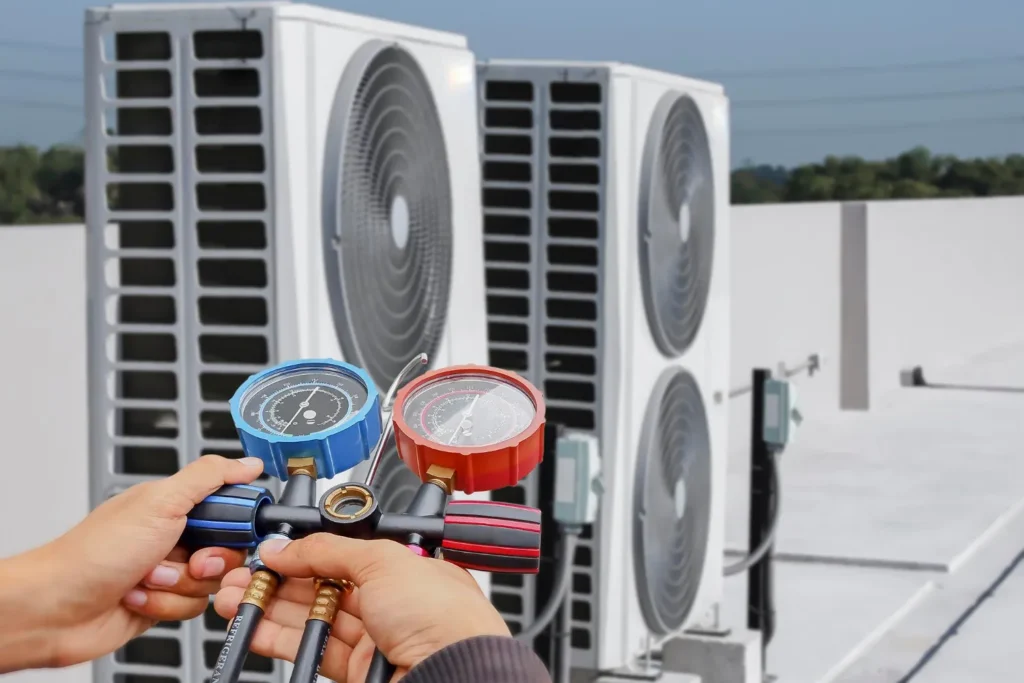Welcome to the comprehensive journey of the AC installation Process, a vital upgrade for comfort in both residential and commercial settings. Based in the bustling climate of Richmond, TX, I’ve been at the forefront of equipping homes and businesses with the best in cooling technology. From selecting the suitable model to the final tweaks of installation, every step is crucial. This guide promises a thorough exploration of the AC installation process, tailored to help you understand the nuances of each phase.
The goal here is not just to install a new AC Unit but to ensure it enhances your living or workspace’s efficiency and comfort. We’ll delve into the types of air conditioning systems available, focusing on their benefits and installation nuances. Whether you’re considering a central air system, a mini-split, or a window unit, understanding the setup process is critical to a successful installation.
Understanding the Basics of AC Systems

Before we discuss the specifics of installation, let’s first understand what an air conditioning installation system entails and the critical components that make it function efficiently. Understanding these basics is important for HVAC installation process professionals as well as for homeowners and business operators who want to make informed decisions about their cooling needs.
Core Components:
- Evaporator Coil: This indoor component is crucial for absorbing heat from the air in your environment. As warm air passes over the cold evaporator coil, the refrigerant inside the coil absorbs heat, cooling the air before it is recirculated back into the room.
- Condenser Coil: Usually located outdoors, the condenser coil releases the absorbed heat into the outside air. This part works in conjunction with the evaporator coil to maintain a relaxed and comfortable indoor temperature.
- Compressor: Positioned within the outdoor unit, the compressor is the heart of your air conditioning system. It pumps refrigerant between the evaporator and condenser coils, which is pivotal for the continuation of the cooling cycle.
- Thermostat: The central control system for your AC, the thermostat monitors and regulates the temperature settings within your space, activating the air conditioning when the indoor temperature exceeds the set point.
Understanding these components is vital as they directly influence the efficiency, performance, and AC maintenance of your air conditioning system. Each component must be correctly installed and maintained to ensure optimal functioning and longevity of your system.
Selecting the Right Type of AC Unit
When choosing an air conditioner installation, consider factors like the size of your space, the local climate in Richmond, TX, and your specific cooling needs. Here’s a brief overview of the types of AC systems:
- Central Air Conditioners: Ideal for cooling multiple rooms or the entire building, these systems require a network of ducts to distribute cool air efficiently.
- Ductless Mini-Split Systems: These are perfect for cooling individual rooms without the need for ductwork. They are also energy-efficient and provide easy installation.
- Window Air Conditioners: These units are convenient for single rooms, are installed in a window, and can be a cost-effective solution for small spaces.
Choosing the right type of air conditioner maximizes comfort and ensures energy efficiency, which is critical in Texas’s heat. In the next sections, we’ll explore how each of these systems is installed and what special considerations need to be taken into account during its installation.
Installation Process of Central Air Conditioning Systems
Central air conditioning systems are a popular choice for comprehensive home and business cooling in Richmond, TX, particularly because they can cool multiple rooms uniformly. Installing a central air system is intricate and requires a detailed understanding of your property’s layout and the system’s components.
Pre-Installation Considerations:
- Load Calculation: Before anything, a precise load calculation must be performed. This determines the size of the AC unit you need, which is crucial to avoid inefficiencies such as energy waste or insufficient cooling.
- Ductwork Inspection and Installation: For buildings without existing ductwork, installing new ducts is a major construction project that involves considerable planning and disruption. If ductwork is already present, it needs a thorough inspection to ensure it’s free of leaks and adequately insulated.
Step-by-Step Air Conditioner Installation Guide:
AC Installation steps:
- Installing the Indoor Unit: This involves setting up the air handler inside, which houses the evaporator coil. It must be placed in a central location within the building for optimal air distribution.
- Setting up the Outdoor Unit: The outdoor unit, which includes the compressor, condenser coil, and fan, needs to be placed on a concrete pad in a location where it can quickly expel heat.
- Connecting Refrigerant Lines: These lines link the indoor and outdoor units, allowing the refrigerant to cycle and facilitate cooling. They must be adequately insulated to prevent energy loss.
- Electrical Connections and Thermostat Installation: Wiring must be completed according to local codes, with a dedicated circuit for the AC unit. Additionally, the thermostat needs to be strategically placed away from direct sunlight and heat sources to read and regulate indoor temperatures accurately.
- System Testing and Air Balancing: After the installation, the system needs to be tested to ensure it functions correctly. This includes checking the refrigerant levels and adjusting air vents for balanced cooling across all rooms.
Installing a central air system in Richmond, TX, demands technical expertise and an understanding of local building codes and regulations. It’s advisable to work with licensed AC installers who can effectively navigate these complexities.
The Role of Mini-Split Systems in Targeted Cooling

Mini-split systems offer a versatile and energy-efficient solution for cooling specific areas of a home or business without the need for extensive ductwork. Their installation is relatively straightforward but requires precision to ensure maximum efficiency.
Key Installation Steps:
- Choosing the Right Location: Both the indoor and outdoor units need to be placed strategically. The indoor unit should be on an exterior wall to simplify the connection to the outdoor unit.
- Mounting the Indoor Unit: This involves securing the indoor unit to the wall, ensuring it’s at the correct height and level.
- Installing the Outdoor Unit: Similar to central systems, the outdoor unit should be placed on a stable, level surface, ideally in a shaded area, to enhance efficiency.
- Connecting the Units: Refrigerant lines, power cables, and a condensate drain line must be run between the indoor and outdoor units. These connections are critical for the system’s operation and must be sealed and insulated correctly.
- System Testing: Once installed, the system should be tested for leaks, electrical continuity, and proper operation to ensure it meets all performance expectations.
Mini-splits are particularly popular in Richmond, TX, for their ability to provide cooling in areas where traditional ducted systems might be impractical. They are also favored for their quick installation and minimal disruption to the existing structure of the property.
Window AC Installation Process

Window air conditioners are a cost-effective and expedient option for single-room cooling. While their installation is less complex than that of central or mini-split systems, ensuring it is done correctly can significantly affect their efficiency and safety.
Window AC Installation Overview:
- Selecting the Appropriate Window: The window should be sturdy enough to support the weight of the unit and be located near an electrical outlet.
- Securing the Unit: After placing the air conditioner in the window, it’s essential to ensure it firmly prevents any movement and seals any gaps around the unit to stop air leaks.
- Electrical Considerations: Ensure the unit is plugged into a properly rated electrical outlet. Extension cords should be avoided as they can pose a fire risk.
- Final Checks: Test the window unit to ensure it operates correctly. Check for any vibrations and make sure the drainage system works effectively, allowing condensation to exit the unit without leaking into your space.
For residents of Richmond, TX, window air conditioners provide a quick fix during the peak summer months. They allow for immediate relief from the heat, especially in spaces where more significant, more complex systems are not feasible.
Conclusion – AC Installation Process
Choosing and installing the right air conditioning system involves careful planning and consideration of your specific needs. Whether you opt for a robust central air system, a flexible mini-split, or a simple window unit, each has its unique installation demands and benefits. By understanding these systems thoroughly, you can ensure your space remains comfortably cool throughout the harsh Texas summers, all while optimizing energy use and minimizing costs.
FAQs About AC Installation Process
What is the best type of air conditioning system for my home in Richmond, TX?
The best type of air conditioning system depends on your specific needs. Central air conditioners are ideal for cooling multiple rooms or entire homes and require ductwork. Ductless mini-split systems are great for targeted cooling without ducts and are suitable for additions or specific rooms. Window units are cost-effective and best for cooling single rooms. Consider factors like the size of your space, cooling needs, and whether you have existing ductwork before deciding.
How long does it typically take to install a new air conditioning system?
Installation times can vary widely depending on the type of AC system and the specifics of your home or business. Central air conditioning systems may take several days to install, especially if new ductwork is needed. Mini-split systems can often be installed in about a day since they require less invasive work. Window units can usually be installed within a few hours.
What should I look for in an AC installation service provider?
Look for a provider with a strong reputation and necessary certifications. They should have extensive experience specifically with the type of AC system you’re installing. Additionally, ensure they offer comprehensive quotes and clear warranties and are knowledgeable about local Richmond, TX building codes and regulations.
How can I ensure my new AC system is energy efficient?
To ensure energy efficiency, choose systems with a high SEER (Seasonal Energy Efficiency Ratio) rating. The higher the SEER rating, the more efficient the unit. Also, if you are using a ducted system, make sure your installation includes proper insulation and sealing of ductwork. Regular maintenance is crucial to keeping your system running at peak efficiency.
What are the most common issues to watch for after a new AC installation?
Common issues include inadequate cooling, unusual noises, and high energy bills, which may indicate improper installation or sizing errors. Ensure your system is tested post-installation by the service team to catch any immediate problems. Also, keep an eye on its performance and contact your installer if something doesn’t seem wrong. Regular maintenance checks can also help identify and rectify issues early.
How much does AC installation cost in Richmond, TX?
The cost of AC installation in Richmond, TX, varies based on several factors, such as the type of air conditioning system chosen, the complexity of your installation, and any necessary modifications or additional features. Central air conditioning installations, ductless mini-split systems, and window units each come with different cost implications due to their varying requirements for ductwork, AC electrical wiring, and unit sizes. Costs can also be influenced by AC permit requirements and specific upgrades like the type of AC refrigerant used or enhancements to the AC air handler. To ensure you get a fair and accurate estimate, it’s advisable to consult with several licensed AC installers who can provide detailed quotes based on your home’s specific needs and the scope of the project.
